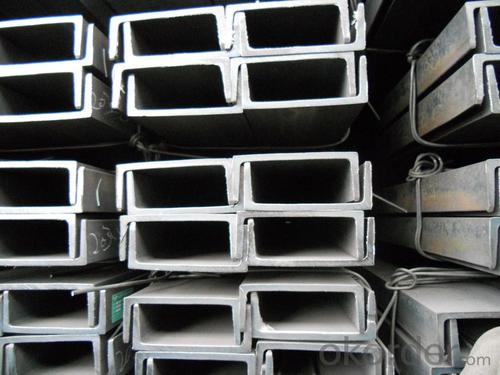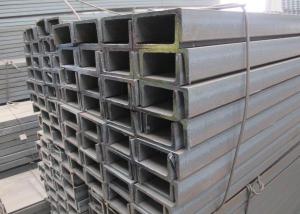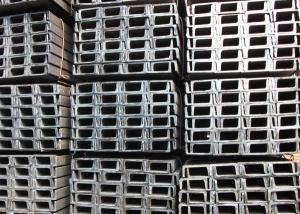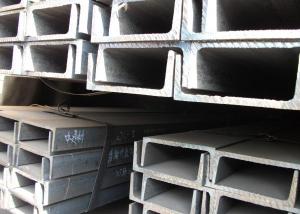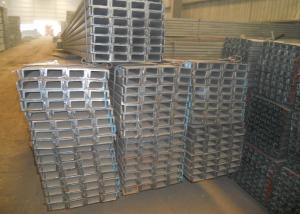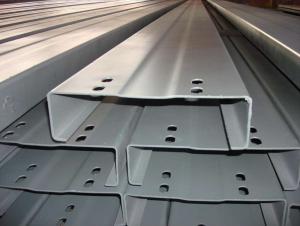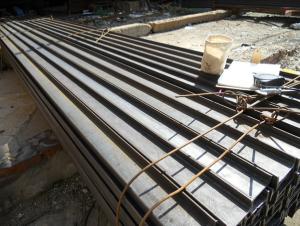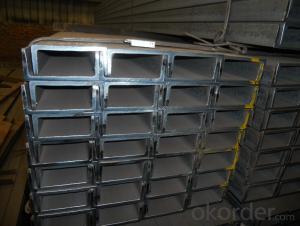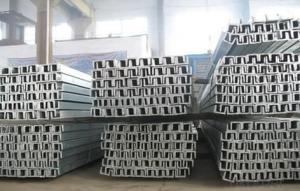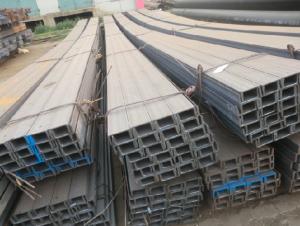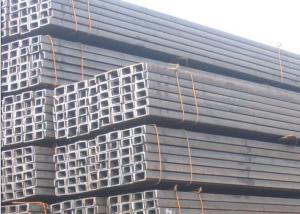Steel Channel 125-150mm
- Loading Port:
- China Main Port
- Payment Terms:
- TT OR LC
- Min Order Qty:
- -
- Supply Capability:
- -
OKorder Service Pledge
OKorder Financial Service
You Might Also Like
Specifications of JIS Channel Steel:
1. We are definitely speciallizing in manufacturing and supplying channel steel as per japanese standard, which is characterised with high mechanical strength and competitive prices.
| Standard | JIS G3192 |
| Material Grade | SS400 |
| Sizes | 50mm to 200mm |
| Sales Volume/Year | 3000MT |
| Destination Area | Middle East, Africa, Southeast Asia |
Size and Mass:
| Size (mm) | Mass (Kg/m) | Size (mm) | Mass (Kg/m) |
| 125*65*5.5 | 12.91 | 150*75*6.0 | 17.9 |
| 125*65*6.0 | 13.4 | 150*75*6.5 | 18.6 |
| 150*75*5.5 | 14.66 | | |
The mechanical property of JIS Channel Steel:
Grade | Yield Strength,N/mm² | Extension Strength N/mm² | |||
Thickness of Steel,mm | |||||
≦16 | >16-≦40 | >40-≦100 | >100 | ||
SS400 | ≧245 | ≧235 | ≧215 | ≧205 | 400-510 |
Package & Delivery of JIS Channel Steel:
1.The channel steel will be packed in bundle with steel wire at each end of every bundle and color marking in order to help the customer to recognize his goods more easily at sight.
2. And the channel steel could be loaded into 20ft or 40ft container, or by bulk cargo.If the weight of each bundle reaches more than 3.5 mt, the loading by break bulk cargo should be choosed.When the weight of each bundle reaches less than 3mt, the loading by container should be choosed.
3.As for the transportaion from mill to loading port, the truck will be usually used. And the maximum quantity for each truck is 40mt.
4.All in all, we could do in accordance with customer's request.
*If you would like to get our price, please inform us the size, standard/material and quantity. Thank you very much for your attention.
- Q: What are the different types of surface treatments for steel channels in marine applications?
- Steel channels used in marine applications can undergo various surface treatments to enhance their durability and corrosion resistance in harsh marine environments. One commonly used treatment is hot-dip galvanizing, where the steel channel is immersed in molten zinc, forming a protective coating that acts as a barrier against corrosion caused by saltwater and other marine elements. Another option is epoxy coating, which involves applying a layer of epoxy paint to the steel channel's surface. This creates a protective barrier that prevents water and oxygen from reaching the steel, minimizing corrosion. Epoxy coatings are particularly effective in marine environments with a high risk of abrasion or impact. Apart from galvanizing and epoxy coating, other surface treatments are available for steel channels in marine applications. These include metalizing, where molten metal is sprayed onto the steel's surface to provide a protective coating, and electroplating, which involves depositing a layer of metal onto the steel using an electric current. There are also specialized marine coatings formulated to withstand the unique challenges of marine environments. These coatings may contain additives or compounds that enhance corrosion resistance and durability. Ultimately, the choice of surface treatment for steel channels in marine applications depends on factors such as the specific environment, required corrosion resistance, and budget. Consulting with a corrosion specialist or engineer is crucial in determining the most suitable treatment for a marine application.
- Q: What are the safety considerations for working with steel channels?
- To ensure the well-being of individuals involved in the process of working with steel channels, it is important to take several safety considerations into account. 1. Personal Protective Equipment (PPE): It is crucial to wear the necessary PPE, which includes safety glasses, steel-toed boots, gloves, and a hard hat. This equipment provides protection against potential hazards such as falling objects, sharp edges, and sparks. 2. Lifting and handling: Steel channels can be heavy and unwieldy. Therefore, it is essential to use proper lifting techniques. This involves bending the knees and using the legs to lift instead of the back. For heavier channels, mechanical lifting devices like cranes or forklifts should be used. 3. Secure storage and stacking: When not in use, steel channels should be stored in a dedicated and stable area. Stacking should be done with care, ensuring that the channels are properly supported and won't topple over. 4. Precautions for cutting and welding: Proper ventilation is crucial while cutting or welding steel channels to prevent inhaling fumes and gases. Adequate ventilation systems should be in place, and workers should wear the appropriate respiratory protection when necessary. To prevent sparks from igniting nearby flammable materials, fire-resistant curtains or shields should be used. 5. Sharp edges and burrs: Steel channels can have sharp edges or burrs that may cause cuts or injuries. Before working with the channels, it is important to inspect and remove any sharp edges or burrs. Wearing cut-resistant gloves can provide an additional layer of protection. 6. Tripping and slipping hazards: Steel channels left unsecured on the ground can create tripping hazards. Workers need to ensure that the work area is free of obstructions or debris that could cause slips or falls. 7. Training and supervision: All individuals involved in working with steel channels should receive proper training and supervision. This includes understanding correct handling techniques, safety protocols, and emergency procedures. Regular safety meetings and inspections should also be conducted to maintain a safe working environment. By considering these safety measures when working with steel channels, the risk of accidents, injuries, and material damage can be significantly reduced, creating a safer and more productive working environment.
- Q: How are steel channels used in construction?
- Steel channels are commonly used in construction to provide structural support in various applications such as framing, bracing, and reinforcing. They are typically used to create beams, columns, and trusses, which offer stability and strength to buildings and other structures. Additionally, steel channels are used as lintels to support openings in walls and as tracks for sliding doors or windows. Overall, steel channels play a crucial role in enhancing the structural integrity and durability of construction projects.
- Q: Are steel channels cost-effective compared to other materials?
- Steel channels are generally considered to be a cost-effective option when compared to other materials. This is due to the fact that steel is widely available and relatively inexpensive. As a result, steel channels are often chosen for construction and manufacturing projects as they provide good value for money. Not only that, but steel channels also offer exceptional strength and durability, enabling them to withstand heavy loads and harsh conditions. This durability leads to long-term cost savings, as steel channels require less maintenance and replacement compared to alternative materials. Moreover, steel is highly recyclable, making it an environmentally friendly choice. Although the initial cost of steel channels may be slightly higher than some other materials, their long-term cost-effectiveness and numerous benefits make them a popular option in various industries.
- Q: What are the different types of support brackets for steel channels?
- There exists a variety of support brackets suitable for steel channels. Below are some commonly used types: 1. Cantilever brackets: Designed to support the steel channel from one end, allowing it to extend freely without support on the other end. They are often used when the steel channel needs suspension or when space is limited for traditional support brackets. 2. L-shaped brackets: Basic and commonly used support brackets for steel channels. They have a 90-degree angle shape, with one side attached to the wall or structure, and the other side supporting the steel channel. L-shaped brackets provide stability and are ideal for securely fixing channels to walls or surfaces. 3. U-shaped brackets: Also known as pipe hangers or pipe clamps, these brackets support steel channels carrying pipes or tubes. The U-shaped design securely holds the channel, providing stability and preventing movement or vibration. They are commonly used in plumbing, HVAC, and electrical installations. 4. Angle brackets: Designed to support steel channels at an angle, these brackets are often used when channels need to be mounted diagonally or require additional support to withstand heavy loads or forces. They are adjustable to different angles, making them versatile for specific installation requirements. 5. Strut brackets: Specifically designed for steel channels within a strut system, these brackets are typically made of metal and have holes or slots for secure attachment. They offer flexibility and adjustability, allowing easy repositioning of the channel as needed. When selecting a support bracket for steel channels, it is essential to consider the specific requirements of your application. Factors such as load capacity, installation method, and environmental conditions should be taken into account to ensure proper support and stability for the steel channel.
- Q: Hello, I have a question to ask you, do a steel hoop, the outer diameter of 1688MM, with 8# steel roll, want to ask next to the long material, 8# channel 43, formula I for (1688-43) *3.14159=5168mm, this material, placed above the rolling machine to roll how, outside diameter it is more than 1688 Oh, I would like to ask, feeding formula should start rolling steel...Is it possible to stretch the roll with a profile bending machine? Can you recommend 1-2 units? It's best to have the approximate price. I'd like to consider whether I can buy one. Thank you
- Count the amount, and in turn count how much it should be minus 1688, and then do it. Or leave a little margin, roll it repaired.
- Q: What are the cost considerations of using steel channels?
- There are several cost considerations to take into account when using steel channels. Firstly, the cost of the steel material itself is a major factor. The price of steel can fluctuate depending on market conditions and availability, so it is important to consider these variables when estimating the overall cost. Another cost consideration is the fabrication process. Steel channels often require cutting, welding, and shaping to meet specific project requirements. The cost of these fabrication processes, including labor, equipment, and materials, should be factored into the overall project budget. Transportation and shipping costs can also add to the total cost of using steel channels. Steel is a heavy and bulky material, so transporting it from the manufacturing facility to the construction site can be expensive, especially if long distances are involved. Furthermore, the installation process should be considered when evaluating the cost of using steel channels. Depending on the complexity of the project, specialized equipment or expertise may be required for proper installation. These additional costs should be considered when estimating the overall project budget. Lastly, it is important to consider the long-term costs associated with steel channels. Steel is known for its durability and longevity, which can result in lower maintenance and replacement costs over time. However, factors such as corrosion protection and regular inspections should be considered to ensure the longevity of steel channels and avoid unexpected expenses in the future. In conclusion, the cost considerations of using steel channels include the cost of the steel material, fabrication processes, transportation and shipping, installation, and long-term maintenance. By carefully considering these factors and conducting a thorough cost analysis, one can make informed decisions regarding the use of steel channels in construction projects.
- Q: What does channel C10 mean? What is the full name of C?
- C steel is different from the channel (such as "C10"), but he also called channel, C10 light is not enough, the leg length, wall thickness, edge are not stereotypes size, must be specifically marked.
- Q: What are the different types of steel channel sections?
- There are several different types of steel channel sections, including C channels, U channels, and Z channels. C channels have a C-shaped cross-section and are commonly used for structural applications such as framing and supports. U channels have a U-shaped cross-section and are often used as edging or trim on metal sheets or as structural components in construction. Z channels have a Z-shaped cross-section and are typically used for framing and support applications where additional strength is required.
- Q: Are steel channels suitable for use in the construction of balconies or terraces?
- Yes, steel channels are suitable for use in the construction of balconies or terraces. Steel channels provide excellent strength and durability, making them a reliable choice for supporting the weight of the balcony or terrace structure. They have high load-bearing capacity and can withstand heavy loads, ensuring the safety and stability of the structure. Additionally, steel channels are resistant to weathering and corrosion, which is crucial for outdoor applications like balconies and terraces. They can withstand exposure to moisture, rain, and sunlight without deteriorating or losing their structural integrity. Furthermore, steel channels offer design flexibility, allowing for various architectural styles and configurations. They can be easily fabricated and installed, making the construction process efficient and cost-effective. Overall, steel channels are a suitable and popular choice for constructing balconies and terraces due to their strength, durability, weather resistance, and design versatility.
Send your message to us
Steel Channel 125-150mm
- Loading Port:
- China Main Port
- Payment Terms:
- TT OR LC
- Min Order Qty:
- -
- Supply Capability:
- -
OKorder Service Pledge
OKorder Financial Service
Similar products
Hot products
Hot Searches
Related keywords



